
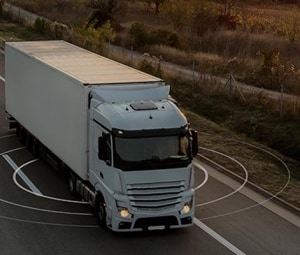
DT-22 is a telematic device for insurtech and fleet management markets (aka ‘BlackBoxes’). The device integrates different algorithm processing to evaluate mileage, location & position, journey tracking, driver style profiling, crash identification and incident reports.
Customer: B810 SRL
The major benefit of this device is the opportunity for stakeholders to provide services like the recovery of stolen devices, geofencing for anti-theft alarm, driver risk analysis and profiling.
- Vehicle Tracking
- Crash Detection
- Driving Risk Detection
- Geofence for Anti-Theft
DESIGN CHALLENGES
The most common installation location for a fleet telematics device is on top of the main battery of the vehicle, where the device is typically powered directly by the battery. The available space under the vehicle’s hood is limited and different for each vehicle and this imposes a strong constraint on the mechanical design of the device.
Metallic components around the telematic device can reduce the signal strength which calls for the use of high efficiency antennas.
On top of this limitation, the small dimension of the device makes it difficult to design in a standard cellular antenna with good performance.
The preliminary solution adopted was an FPC antenna installed on the top cover with a cable and UMCC connector. However, due to the proximity to the main board, this solution achieves performance in terms of radiated signal strength. The result was a poor coverage and unreliable network connection, unacceptable for TE’s quality standards and bad for customer experience.
Furthermore, the use of UMCC connectors may result in assembly problems in the manufacturing process and/or in instability of the connection when the product is exposed to vibration due to the installation in the vehicle engine compartment.
SOLUTIONS
B810 SRL and the TE engineering department worked together to design a custom laser direct structuring (LDS) antenna. This LDS technology allows any 3D conductive structure to be formed on a plastic molded device, maximizing the usage of available space and giving the antenna engineer the freedom to design sophisticated conductive patterns to cover a broad band bandwidth such as required especially for cellular antennas. The first concept has been presented in November 2020.
TE engineering simulated the antenna performance on different PCB sizes and checked the influence of nearby components which finally helped to reduce PCB size by 30%.
Another advantage of LDS antennas is the integration of multiple antennas on one plastic carrier leading to a reduced number of components with very little additional costs. In this case, the Bluetooth ceramic chip antenna was replaced by a second LDS structure in parallel to the LTE/GSM antenna at the cost of just one spring finger.
The antennas were connected by TE gold plated spring fingers with long-time
stability under harsh environments. Antenna fixture is established by just two screws and the assembly has been made easy by an alignment feature with the PCB.
EXECUTION
After the simulation and mechanical design was done in early February 2021, TE was able to work with one of its distributors, Avnet, and built 20 samples within 2 weeks by a rapid prototype process without the need to invest in mold tools at that stage.
B810 SRL verified the antenna dimensions and sent 2 devices to TE and Avnet for radiation measurement. After verification, the production tool was built. TE and Avnet supplied sample quantities of 100 and 1000 pieces for evaluation before starting with mass production in September 2021.
OUTCOMES
The LDS antenna with optimum radiation efficiency and easy and reliable mounting
method was successfully integrated into the new design of the DT-22 devices, meeting operating requirements even in dense urban environments where connectivity signal level can be poor or insufficient.
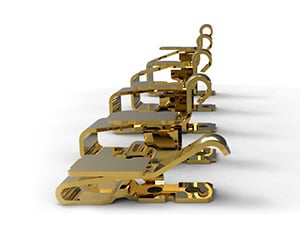
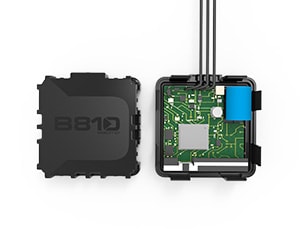
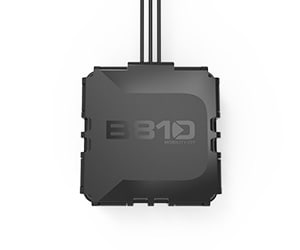
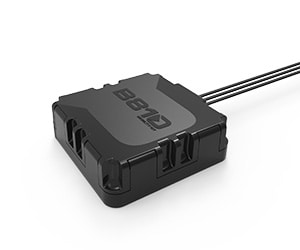


DT-22 is a telematic device for insurtech and fleet management markets (aka ‘BlackBoxes’). The device integrates different algorithm processing to evaluate mileage, location & position, journey tracking, driver style profiling, crash identification and incident reports.
Customer: B810 SRL
The major benefit of this device is the opportunity for stakeholders to provide services like the recovery of stolen devices, geofencing for anti-theft alarm, driver risk analysis and profiling.
- Vehicle Tracking
- Crash Detection
- Driving Risk Detection
- Geofence for Anti-Theft
DESIGN CHALLENGES
The most common installation location for a fleet telematics device is on top of the main battery of the vehicle, where the device is typically powered directly by the battery. The available space under the vehicle’s hood is limited and different for each vehicle and this imposes a strong constraint on the mechanical design of the device.
Metallic components around the telematic device can reduce the signal strength which calls for the use of high efficiency antennas.
On top of this limitation, the small dimension of the device makes it difficult to design in a standard cellular antenna with good performance.
The preliminary solution adopted was an FPC antenna installed on the top cover with a cable and UMCC connector. However, due to the proximity to the main board, this solution achieves performance in terms of radiated signal strength. The result was a poor coverage and unreliable network connection, unacceptable for TE’s quality standards and bad for customer experience.
Furthermore, the use of UMCC connectors may result in assembly problems in the manufacturing process and/or in instability of the connection when the product is exposed to vibration due to the installation in the vehicle engine compartment.
SOLUTIONS
B810 SRL and the TE engineering department worked together to design a custom laser direct structuring (LDS) antenna. This LDS technology allows any 3D conductive structure to be formed on a plastic molded device, maximizing the usage of available space and giving the antenna engineer the freedom to design sophisticated conductive patterns to cover a broad band bandwidth such as required especially for cellular antennas. The first concept has been presented in November 2020.
TE engineering simulated the antenna performance on different PCB sizes and checked the influence of nearby components which finally helped to reduce PCB size by 30%.
Another advantage of LDS antennas is the integration of multiple antennas on one plastic carrier leading to a reduced number of components with very little additional costs. In this case, the Bluetooth ceramic chip antenna was replaced by a second LDS structure in parallel to the LTE/GSM antenna at the cost of just one spring finger.
The antennas were connected by TE gold plated spring fingers with long-time
stability under harsh environments. Antenna fixture is established by just two screws and the assembly has been made easy by an alignment feature with the PCB.
EXECUTION
After the simulation and mechanical design was done in early February 2021, TE was able to work with one of its distributors, Avnet, and built 20 samples within 2 weeks by a rapid prototype process without the need to invest in mold tools at that stage.
B810 SRL verified the antenna dimensions and sent 2 devices to TE and Avnet for radiation measurement. After verification, the production tool was built. TE and Avnet supplied sample quantities of 100 and 1000 pieces for evaluation before starting with mass production in September 2021.
OUTCOMES
The LDS antenna with optimum radiation efficiency and easy and reliable mounting
method was successfully integrated into the new design of the DT-22 devices, meeting operating requirements even in dense urban environments where connectivity signal level can be poor or insufficient.




